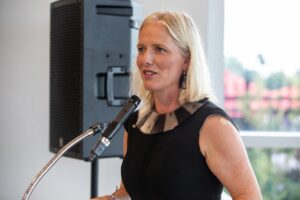
People & Culture
Kahkiihtwaam ee-pee-kiiweehtataahk: Bringing it back home again
The story of how a critically endangered Indigenous language can be saved
- 6310 words
- 26 minutes
This article is over 5 years old and may contain outdated information.
People & Culture

Jeff Fuchs’ eyes sparkle as he recalls the moment he first heard mention of the Tea Horse Road — a treacherous 5,000-kilometre mountain trade route linking southern China’s traditional tea producing areas with Tibet, Nepal and northern India. It was as though “there was a small little hook being put into my skin,” he says.
Fuchs’ exploration of this daunting yet relatively unheralded ancient trade network — which predates the better-known Silk Road and was active without interruption for at least 1,300 years — began with his arrival in Taiwan almost 20 years ago. Fuchs, who is originally from the Ottawa Valley, planned to work there as a freelance photographer. But he soon became immersed in the local tea culture, learned Mandarin and then moved to Yunnan on the mainland, home to some of the world’s oldest, most sought-after and expensive teas. It was there that he learned of the Tea Horse Road. Fuchs settled, literally, in Shangri-la, and spent the next decade exploring the route’s countless spurs and offshoots, learning about tea, meeting the last of the route’s old traders and tea makers and documenting their stories.
Fuchs trekked the full length of the Tea Horse Road in 2006, the first westerner to do so. He retraced parts of that trip and others with filmmaker Andrew Gregg in 2015, which resulted in a documentary, The Tea Explorer. Released in 2017, it has aired on the CBC and screened at festivals around the world. Earlier this month, the film opened the Toronto Tea Festival. Canadian Geographic sat down with Fuchs, who now lives in Hawaii, in a friend’s kitchen in Toronto to talk about the Tea Horse Road, his experiences in China and the film — all over cups of his favourite pu-erh tea, of course.
CanGeo: At the beginning of The Tea Explorer, you describe your introduction to “learning the leaf” when you had an unlikely invitation to a tea gathering in Taiwan. Can you recount that?
Jeff Fuchs: My first months in Taiwan, I was invited by someone I’d met to “immerse in a thoroughly Taiwanese experience,” and of course I was reading this as metaphorically being a date of some sort. I was picked up by a woman on a 50cc scooter in downtown Taipei, given a helmet, popped onto the back and we screamed off into the mountains of Maokong, which surround Taipei.
We arrived at a tea restaurant in an area entirely dedicated to tea junkies — they bring their own pots, they bring their own varietals, often some of them are tea farmers. There were a dozen people there, it was late in the day, and we sat down and started drinking tea. The meal came. We continued drinking tea. I realized at about 9:30 or 10 that we weren’t anywhere close to being finished. And this went on — another meal, and another meal. I would think, okay, things are coming to an end, and then another person would introduce their tea. We watched the sun come up at six. We’d been there a total of 12 hours at the end. I was ripped for two days. And that was my introduction to learning that the dedicates of the leaf are truly dedicates of the leaf.
CG: That was enough to turn your curiosity into a passion?
JF: Yeah, I was hooked. One of the first things I did was I tried to find a mentor. But the best mentors inevitably are local people who don’t speak much English. So I learned Mandarin specifically to start understanding this terminology of tea. It has a very specific nuance and a very specific language that in English we don’t in many cases even have words for — for the flavour components, the effect of that first rush. I was willing to commit to learning a language to understand a little bit more about their perspectives on tea.
CG: What took you inland from Taiwan?
JF: A Taiwanese tea maker said if you really want to go into tea, you actually have to stop talking about it, stop thinking about it, and go to the heart of it, the origin of all tea. So I took a trip to southwestern Yunnan. In southwestern Yunnan you walk into forests that are centuries old and the forest is tea trees. They grow wild and gnarly like a bizarre orchard. For people there, tea is a fuel and foodstuff, very simple, and yet some of the most coveted teas in the world come from that zone. They’re coveted because they’re produced so simply and so cleanly.
My tea education in Taiwan was detailed, intricate and linguistic; in southwestern Yunnan it was very much a thing of simplicity. There weren’t so many flowery conversations about the leaf, but there was definitely that good feeling again. There is a saying in the mountains that if a cup of tea isn’t offered, a relationship isn’t offered. It’s so simple, and yet it binds communities. I love the lore of tea, I love the feeling of tea, but at the heart of it, I love the way tea binds people to people and moments. It’s a very visceral thing.

CG: How did you go from that to becoming an explorer on the Tea Horse Road?
JF: My first journey to Yunnan, I had planned to do a small expedition, a summit of a mountain [in the northwest], but there was a blizzard, so we didn’t go up. I was stuck for three weeks, and I met a Tibetan named Dakpa, a very charismatic local who had spent much of his childhood in India as a monk. We chummed around and on one walk we were wandering through a little stony mountain pass, and he pointed out this little striding route that went on a diagonal up a mountain, and he said something like, “That’s the walkway that I came back here from India on.” Then I found out that the walk was actually months long and treacherous and you barely have anything but robes to wear and butter tea to drink. He mentioned the Tea Horse Road, and it was like there was a small little hook being put into my skin. So I moved from Taiwan specifically to be amongst the mountains, and made a pledge with Dakpa that somehow we were going tell the story and travel as much as we could. And that never really stopped. It’s still going on now.
The Tea Horse Road is not one main hub highway, it’s a series of striating routes that bend all over the mountains and then reconvene. What astounds me to this day is that we don’t know more about it. A 5,000-kilometre route through the sky, ushering commodities all over the Himalayas, into India, China, Nepal for over 1,300 years, unending, unceasing, and we don’t have much context about it. We know the Silk Road because it touched our hearts as old Europeans, but this is an incredible route that built the Himalayas and not much was written about it.

CG: What is the origin of the name?
JF: It was coined in Mandarin as the Tea Horse Road or the Tea Horse Way. The official designation by the Han people came during the Song Dynasty, when a lot of the Chinese kingdoms were trying to build cavalry. As they were giving tea as a tribute to the warrior masses on the Tibetan plateau, they also discovered that the Tibetans had these war ponies, sort of like the Himalayan equivalent of camels. They were rough, ornery, but they provided a basis for building cavalries, by which these Chinese kingdoms could keep some of the northern peoples away. So it became almost an exchange of sorts, of horses and tea. But you also had medicinals flowing, you had opium being traded, so in some ways maybe the Tea Horse Road moniker isn’t accurate. The Tibetans just called it the Gyalam — the wide road or the tea road.
CG: At the screening of The Tea Explorer in Toronto, you asked the audience to pay attention to a couple of specific characters: a gentleman named Konga in Upper Mustang, Nepal, and an older woman in Yunnan. Why do they stand out for you?
JF: Konga was one of the last of the traders up in Mustang, and he made an impression simply because of his wide-eyed yet gritty ability to sum up the route. He was this rugged pit bull of a man who kept asking us, “Well, why are you interested in me? I’ve done nothing special.” I think it’s a great counterpoint to the hubris in the world of exploration to talk to someone in his 75th year who says almost nothing about himself. You don’t hear the words I, me, my. But in his simple way, he clarified so much of what the route was about. Konga, for me, is the face of the Tea Horse Road. He represents some of the inherent qualities of this trade route — expansive, utterly magnificent and full of humility.
The woman, Drolma, lived very close to me in a small satellite community of northwestern Yunnan, near a place called Benzilan. She was this soft-spoken woman we’d interviewed many times, with hands like cleavers. And she had mentioned how, in the days of the Tea Horse Road, she would go with her father. He was afraid to leave her at home because she was a blossoming beauty. But in that time period, women weren’t supposed to be on the route; it was viewed as a place of danger and risk. So she learned to dress as a boy and then a man. Subsequently she became quite an efficient trader in her own right, always dressed and acting as a man, another one of those epic spirits who represents the Himalayan way of things: unassuming, unapologetic, utterly tough.

CG: The flip side of that is all the changes you document in the tea regions — the intrusion of coffee culture, particularly in the cities, economic change, and generational change. In that sense, is this a story about something that’s dying or is dead?
JF: I’d maybe go back to the word you used: change. Change itself isn’t the enemy, necessarily. The elders along the trade route, who you’d assume would be very conservative and staid and traditional in their values, talk very liberally about how good roads are in terms of access to goods and family. I think what’s frightening is the speed of change and how that change is managed. To see a mountaintop cut off while excavators go in to mine a rare earth metal over a two-month period, that’s an intense change — a sacred mountain being cleaved in half. I don’t necessarily think that things are dying, but I think the speed of change, the intensity of change, and maybe the slight disconnect that’s happening from a cultural perspective, has pulled some of the tendons from the community in a very short period.
Are you passionate about Canadian geography?
You can support Canadian Geographic in 3 ways:

People & Culture
The story of how a critically endangered Indigenous language can be saved

People & Culture
The history behind the Dundas name change and how Canadians are reckoning with place name changes across the country — from streets to provinces

History
A look back at the early years of the 350-year-old institution that once claimed a vast portion of the globe

People & Culture
A century after the first woman was elected to the Canadian Parliament, one of the most prominent figures in present-day politics shares her thoughts on how to amplify diverse voices in the Commons